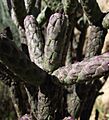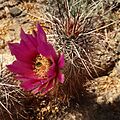List of flora of the Mojave Desert region facts for kids
This article explores the amazing plants that grow in the Mojave Desert region. This includes plants found in the desert itself and in the mountains around it. Some of these plants grow even higher than the famous Joshua Trees, which are a symbol of the Mojave Desert. We'll also look at plants from the Little San Bernardino Mountains, which separate the Mojave Desert from the Colorado Desert.
You'll find different ways to explore these plants here. We'll look at some of their common names and learn about their special features.
Desert Plants by Common Name
Let's discover some of the cool plants you might find in the Mojave Desert, listed by their common names.
Iconic Desert Trees and Shrubs
- Joshua Tree (Yucca brevifolia): This is perhaps the most famous plant of the Mojave Desert! It's a type of Yucca and can grow quite tall, looking like something from a Dr. Seuss book. Its spiky leaves and unique shape make it easy to spot.
- Creosote bush (Larrea tridentata): This tough shrub is very common. It has small, waxy leaves that help it save water. After it rains, the creosote bush gives off a strong, fresh smell that many people associate with the desert.
- Desert willow (Chilopsis linearis): Even though it's called a willow, it's not a true willow tree. It has beautiful, trumpet-shaped flowers that can be pink, purple, or white. It's often found near washes or areas with more water.
- Honey mesquite (Prosopis glandulosa ver. torreyana): This tree has long thorns and produces sweet pods that can be eaten. It's a vital food source for many desert animals.
- Desert almond (Prunus fasciculata): This shrub is related to the almond trees that produce nuts. It has small leaves and can be found in rocky areas.
- Four-winged saltbrush (Atriplex canescens): This shrub is known for its unique, four-winged seeds. It's very tolerant of salty soils.
- Big sagebrush (Artemisia tridentata): A fragrant shrub that dominates many desert landscapes, especially at higher elevations. It has silvery-green leaves.
- Blackbrush (Coleogyne ramosissima): This thorny shrub forms dense thickets and is a key plant in many parts of the Mojave Desert.
Cacti and Their Amazing Adaptations
Cacti are masters of desert survival! They store water in their stems and have spines to protect themselves.
- Beavertail cactus (Opuntia basilaris): This cactus has flat, paddle-shaped pads that look like a beaver's tail. Its pads are often purplish and it produces beautiful pink or magenta flowers.
- Silver cholla (Cylindropuntia echinocarpa): This cactus has a silvery appearance due to its dense spines. Its segments can easily break off and attach to anything that brushes against them, helping the plant spread.
- Pencil cholla (Cylindropuntia ramosissima): This cactus has thin, pencil-like stems. It's less spiky than other chollas but still has sharp spines.
- California barrel cactus (Ferocactus cylindraceus): This large, barrel-shaped cactus can grow quite tall. It has strong, hooked spines and often leans towards the south, earning it the nickname "compass cactus."
- Hedge-hog cactus (Echinocereus engelmannii): This cactus grows in clumps and has colorful flowers, often pink, purple, or red.
- Mojave prickly-pear (Opuntia polyacantha var. erinacea): This prickly pear has flat pads covered in many long, bristly spines, giving it a "hairy" look.
Colorful Desert Wildflowers
After a good rain, the desert can burst into a riot of color with these wildflowers.
- Desert marigold (Baileya multiradiata): These bright yellow flowers look like small sunflowers and are a cheerful sight in the desert.
- California poppy (Eschscholzia californica): While famous in California, this vibrant orange poppy also blooms in parts of the Mojave Desert.
- Desert gold-poppy (Eschscholzia glyptosperma): A smaller, delicate yellow poppy that brightens up the desert floor.
- Desert five-spot (Eremalche rotundifolia): This unique flower has five petals, each with a distinctive red spot at its base, making it look like a target.
- Desert paintbrush (Castilleja chromosa): These plants have bright red or orange bracts (modified leaves) that look like they've been dipped in paint.
- Desert lily (Hesperocallis undulata): A beautiful white lily that emerges from the sand after winter rains, often called the "Queen of the Desert."
- Desert sand-verbena (Abronia villosa var. villosa): These plants have clusters of fragrant pink or purple flowers and often grow in sandy areas.
- Purple mat (Nama demissum): A low-growing plant that forms a carpet of small purple flowers on the desert floor.
- Ghost-flower (Mohavea confertiflora): This striking white flower has purple spots and looks almost translucent, giving it its ghostly name.
Other Interesting Plants
- Desert trumpet (Eriogonum inflatum): This plant has hollow, swollen stems that look like trumpets, often used by ants as homes.
- Jimson weed (Datura wrightii): A large plant with beautiful, fragrant white trumpet-shaped flowers that open at night.
- Desert mistletoe (Phoradendron californicum): This parasitic plant grows on other desert trees, especially mesquite, and produces small, sticky berries.
- Indian ricegrass (Stipa hymenoides): An important native grass that was traditionally used by Native Americans for food.
- Puncture vine (Tribulus terrestris): This plant produces hard, spiky seeds that can easily puncture bicycle tires, hence its name.
Images for kids











